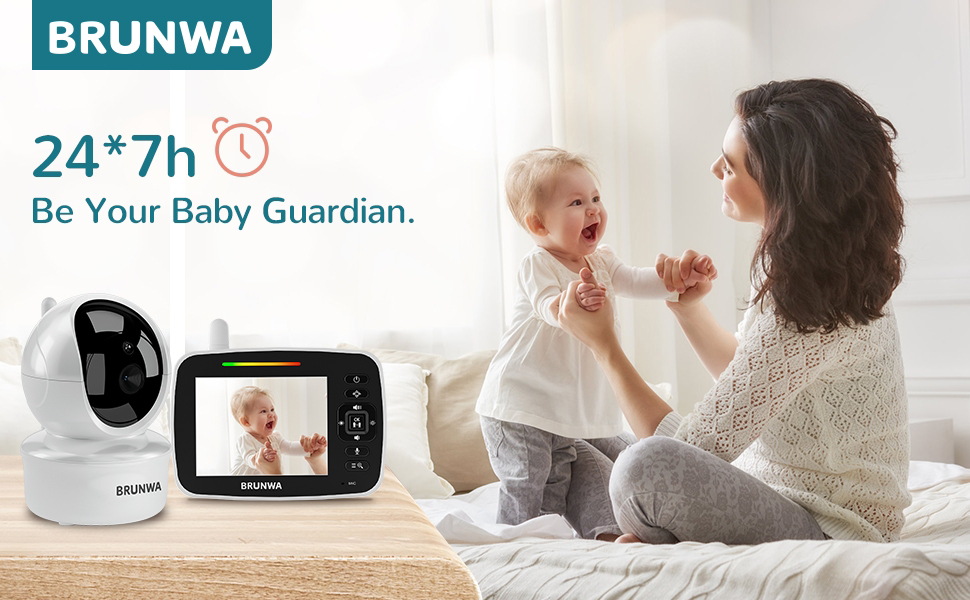Brunwa Baby Monitor
Parenting comes with its fair share of worries—especially when it comes to keeping an eye on your little one while tackling daily tasks. This is where a baby monitor becomes a lifesaver, allowing parents to stay connected to their baby even when they’re in another room. The Brunwa Baby Monitor promises a secure and efficient way to do just that. But what makes it stand out? Let’s dive into its features and see if it lives up to the expectations of modern parents.o
Reliable Connection for Peace of Mind
One of the most important aspects of a baby monitor is its connection stability. The Brunwa Baby Monitor operates on a 2.4GHz FHSS frequency, which ensures a secure and interference-free connection between the parent unit and the baby unit. Unlike Wi-Fi-based monitors, this dedicated frequency minimizes the risk of hacking or disruptions, giving parents peace of mind that their baby’s moments are transmitted safely and privately.
The monitor boasts an impressive 900ft range (in an open, unobstructed space), allowing parents to move freely around the house while staying connected. However, walls, furniture, and electronic devices may slightly affect the actual range—something to keep in mind depending on your home layout.
Clear Visuals, Even at Night
Let’s talk about the display. The 3.5” LCD screen on the parent unit offers a clear view of your baby, ensuring you don’t miss a single adorable stretch or sleepy smile. The color CMOS image sensor enhances image quality, making it easier to check in on your baby without second-guessing what you're seeing.
But what about nighttime? Parents know that sneaking into the nursery to check on a sleeping baby often results in an accidental wake-up call. That’s where the 940nm IR LED night vision comes in handy. Without any disruptive lights, this feature allows parents to see their baby in the dark, ensuring a peaceful night’s rest for both baby and caregivers.
Battery Life That Keeps Up with Parenthood
A baby monitor is only as good as its battery life. Thankfully, the Brunwa Baby Monitor doesn’t disappoint. With ECO mode activated, the parent unit can last up to 12 hours on a full charge. This means fewer interruptions to recharge—because let’s be honest, parents already have enough to remember!
The power adapter is also globally compatible (100-240V input, 5V output, 700mA), making it a convenient option for families who travel or move frequently.
Designed for Practical Use
While the Brunwa Baby Monitor packs plenty of useful features, it’s important to note that it is designed for indoor use only, with an optimal temperature range of 0-40°C and humidity tolerance of 5%-90%. This means that extreme temperature changes or high humidity levels may impact its performance.
Additionally, the package includes everything you need to get started:
1 Parent Unit (3.5” LCD display)
1 Baby Camera
2 Power Adapters
1 Mount Kit (for flexible placement)
1 User Manual (because no one likes guessing how to set up new
Is It Worth It?
Choosing the right baby monitor depends on your specific needs. If you’re looking for a non-Wi-Fi, interference-free device with clear visuals, long battery life, and night vision, the Brunwa Baby Monitor is a solid choice.
Of course, no product is perfect. While its 900ft range sounds impressive, real-world performance will depend on home layout and obstacles. Additionally, the lack of smartphone connectivity might be a downside for parents who prefer app-based monitoring.
Ultimately, this baby monitor caters to parents who want a simple, secure, and reliable way to keep an eye on their little one—without the complications of Wi-Fi or smart home integrations. Before purchasing, it’s always a good idea to check user reviews to ensure it aligns with your specific expectations.
At the end of the day, peace of mind is priceless—and if a baby monitor helps you worry less and sleep a little better, it’s already worth considering!

Comments
Post a Comment